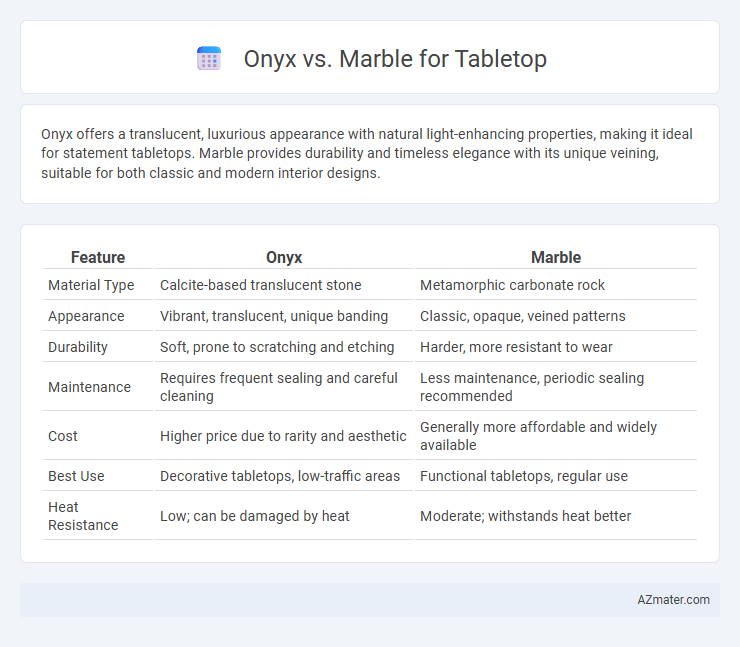Onyx offers a translucent, luxurious appearance with natural light-enhancing properties, making it ideal for statement tabletops. Marble provides durability and timeless elegance with its unique veining, suitable for both classic and modern interior designs.
Table of Comparison
| Feature | Onyx | Marble |
|---|---|---|
| Material Type | Calcite-based translucent stone | Metamorphic carbonate rock |
| Appearance | Vibrant, translucent, unique banding | Classic, opaque, veined patterns |
| Durability | Soft, prone to scratching and etching | Harder, more resistant to wear |
| Maintenance | Requires frequent sealing and careful cleaning | Less maintenance, periodic sealing recommended |
| Cost | Higher price due to rarity and aesthetic | Generally more affordable and widely available |
| Best Use | Decorative tabletops, low-traffic areas | Functional tabletops, regular use |
| Heat Resistance | Low; can be damaged by heat | Moderate; withstands heat better |
Introduction to Onyx and Marble Tabletop Materials
Onyx tabletops are composed of a translucent, carbonate mineral prized for its unique, swirling patterns and warm, glowing appearance created by natural light penetration. Marble tabletops, made from metamorphosed limestone, are renowned for their classic veining, durability, and wide range of colors, offering elegance and timeless appeal. Both materials require sealing and regular maintenance to preserve their surface integrity against stains and scratches.
Aesthetic Differences: Onyx vs Marble
Onyx exhibits a striking translucency and rich, layered patterns with vibrant veins, offering a unique, glowing aesthetic ideal for dramatic tabletops. Marble presents a classic elegance with softer, more uniform veining and a matte or polished finish that complements traditional and contemporary designs. The choice between onyx and marble for tabletops depends on desired visual impact--onyx creates a bold, luxurious statement while marble provides timeless sophistication.
Durability and Strength Comparison
Onyx tabletops offer a luxurious, translucent appearance but are significantly softer and more prone to scratching and chipping compared to marble. Marble is renowned for its superior durability and hardness, making it more resistant to heat, scratches, and everyday wear. For high-traffic areas or frequent use, marble provides a stronger, longer-lasting surface, while onyx requires more delicate handling to maintain its aesthetic appeal.
Maintenance and Cleaning Requirements
Onyx tabletops require delicate maintenance due to their porous nature, needing regular sealing to prevent stains and damage from acidic substances. Marble surfaces also demand frequent sealing but are generally more resistant to etching, with care routines involving gentle cleaning using pH-neutral detergents to preserve their polished finish. Both materials are vulnerable to scratches and require soft cloths for cleaning to maintain their aesthetic appeal and longevity.
Cost Analysis: Onyx vs Marble Tabletop
Onyx tabletops typically cost 50-70% more than marble due to their rarity and translucency that requires specialized extraction and finishing techniques. Marble offers a more budget-friendly option, with prices varying based on origin and veining patterns, often making it the preferred choice for large-scale projects. Maintenance costs for onyx are generally higher because its softer composition demands more frequent sealing and repairs compared to the more durable marble surface.
Suitability for Home and Commercial Use
Onyx offers a striking, translucent appearance ideal for decorative tabletops in homes, but its softness and susceptibility to scratching make it less suitable for high-traffic commercial settings. Marble provides superior durability and resistance to wear, making it a practical choice for both residential and commercial tabletops where heavy use is expected. Both materials require sealing and regular maintenance to preserve their aesthetic appeal, with Marble offering better longevity under frequent use conditions.
Stain and Scratch Resistance
Onyx tabletops are known for their striking translucency but tend to be softer, making them more susceptible to stains and scratches compared to marble. Marble, composed primarily of calcite, offers better resistance to scratches and is less prone to staining when properly sealed. Choosing marble for tabletops ensures enhanced durability and easier maintenance in high-traffic or frequently used areas.
Variety in Colors and Patterns
Onyx tabletops offer a unique range of translucent colors including honey, green, and red hues, characterized by striking swirling patterns that add luxury and depth to any space. Marble tabletops present a classic appeal with a wide variety of shades such as white, black, gray, and green, often featuring elegant veining patterns that create a timeless aesthetic. The choice between onyx and marble depends on preference for vibrant translucence versus traditional, sophisticated veining in color variety and pattern expression.
Environmental Impact and Sustainability
Onyx and marble differ significantly in environmental impact and sustainability; onyx extraction often involves more intensive quarrying processes, leading to higher ecological disruption, while marble is relatively abundant and its quarrying tends to have a lower carbon footprint. Both materials require substantial energy for cutting and polishing, but marble's widespread availability typically results in reduced transportation emissions compared to onyx, which is rarer and often sourced from distant locations. Choosing marble for tabletops generally supports better sustainability practices due to its natural abundance and lower overall environmental costs.
Final Verdict: Choosing the Right Tabletop Stone
Onyx offers a unique, translucent beauty with rich color variations, ideal for statement tabletops but requires careful maintenance due to its softness and susceptibility to scratches. Marble provides timeless elegance and durability, with a wide range of patterns and better resistance to heat and stains, making it more practical for everyday use. Selecting the right tabletop stone depends on balancing aesthetic preferences and durability needs, with marble favored for longevity and onyx chosen for distinctive, luxurious appeal.

Infographic: Onyx vs Marble for Tabletop
 azmater.com
azmater.com